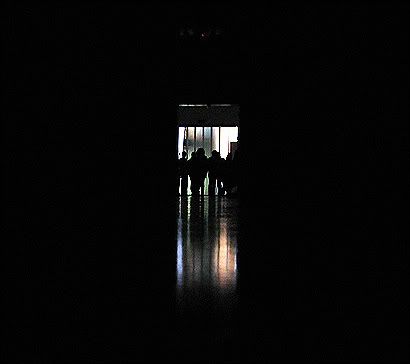the lights off

The most delightful thing about Martin Creed's 'The Light's Off' is its ambiguity. Is it merely a simple installation? Is it a deliberate courting of controversy? Is it an intentionally scathing critique of the state of contemporary art, or merely a sad reflection of its intellectual bankruptcy? Is it a moving representation of deep philosophical and spiritual issues? Or is it a cynical con?
The first thing that everyone will notice about the work is the idea. Few people will encounter the work who have not first encountered the idea of the work, namely that it consists of three rooms in a gallery left empty and unlit. While the same might be said of any remotely famous work of art, that its reputation will precede its direct experience, the idea of the Sistine Chapel ceiling is much less important to it as a work of art than the idea is to 'The Lights Off'. While it would have been delightful to have encountered it without expectations, it seems an unlikely prospect.
Whether one is passionately engaged with, or overtly hostile to, the contemporary exaltation of concept over skill in art, this work is the icon of that trend. For those who think that their young niece could easily reproduce the work of Picasso or Rothko, it stands as a final proof of the abject degeneracy of modern art. For those of us who are looking for something to think about, it provides equally plentiful ammunition. That the artist refrained from offering any further interpretive cues gives wide range to our meanderings.
We might see in it an indictment of the state of contemporary art, overly commodified and devoid of content. Or we might understand it as a cheeky publicity stunt on the part of an artist whose art consists of courting controversy.
Mostly these are reactions to the idea itself. And while the idea is of course a large part of this work, it is not the whole. My reaction to the work itself was quite different from my reaction to the idea. I thought the idea was interesting and clever, but maybe a bit too clever. It seemed unsubtle and smart-arsey. But encountering the work transformed my response.
It's not just a dark room. It's three rooms, each further from the gallery's main source of light, which at the moment is ambient daylight filtering in through the glass front doors from the street. The first room is dimly lit, the second even more so, and the third is dark, save for the pale remains of light that have filtered through those two rooms, and a lit green sign marking an emergency exit.

Because it is day time, because we are so used to experiencing public buildings, and especially art galleries, as brilliantly lit, and because we have come here to see 'The Lights Off', we are made much more aware of the darkness than we would otherwise be. We do not experience it as the natural absence that it ordinarily is, but rather as an active presence, a thing in itself. Experiencing it in this way, as having been put there, made the work seem an expertly crafted installation, rather than just a smart-alecky idea.
As we went through the rooms, we necessarily became less able to see. The world that we live in now is highly visual, and almost always well lit. Obvious exceptions are nightclubs and churches. This work shows us that just as in those examples, a purposefully constructed darkness necessarily has a powerful psychological, emotional, even spiritual effect. While not especially reminiscent of a nightclub, proceeding through the increasingly dark spaces, and looking back out to the source of the light, necessarily reminded me of a cave or a crypt, inviting reflections on death and rebirth as surely as any cathedral.
For me it also invited further reflection on the western histories of negative theology and its solipsistic inverse, existentialism. The question of how best to express an absence is of central importance to both contemporary philosophy and religious history. And yet i am soon roused from such reveries by the knowledge that all the artist has done is switch the lights off.
That in doing so he has invited these and many more responses is surely a masterstroke. Overriding all of these responses is this, the work's whimsy and wit. The artist of course knows it will be read in terms of philosophy and religion, and also as talentless pretense. To have created such a work in the face of this knowledge surely requires a smirk and a sparkle in the eye that few of us could muster. For me, it is this cheekiness and sense of fun that elevates it beyond merely being a remarkable and moving work, to one of historical importance.

0 Comments:
Post a Comment
<< Home